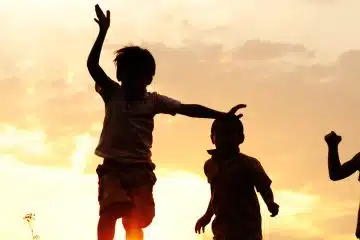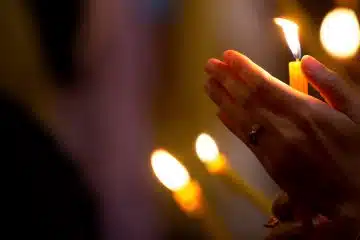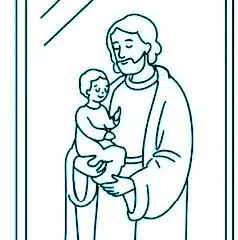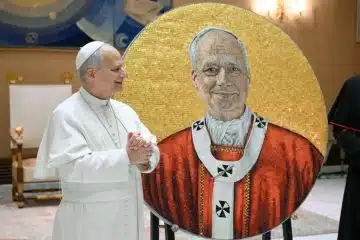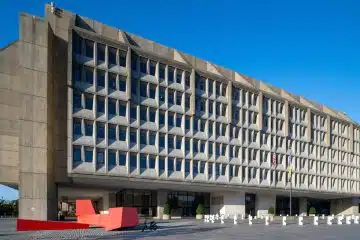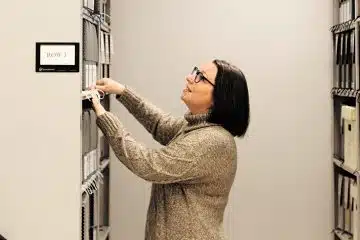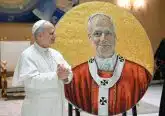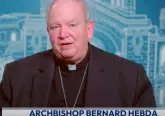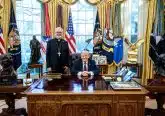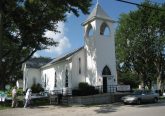Military chaplaincy has long history in U.S. armed forces

IMAGE: CNS illustration/Liz Agbey
By Chaz Muth
COLUMBIA, S.C. (CNS) — When Father Adam Muda arrived at the U.S. Army Chaplain Center and School at Fort Jackson earlier this year, he noticed prominent signs for a museum that showcased the history of what he was about to become.
The U.S. Army Chaplain Corps Museum has such a prominent place where priests and clergy from other religions train to be chaplains, because the role of the chaplain is stitched into the fabric of the U.S. military.
The patchwork of the military chaplaincy was revealed on a warm March morning as the museum’s curator, Marcia McManus, walked a visitor through the carefully lit exhibit hall with a scent that reminded him of vintage books and photographs.
The man noticed the displays were laid out in chronological order, beginning with the origin of the name chaplain, which derives from the relic cape (“cappa” in Latin) of St. Martin of Tours, a second-century bishop who is said to have used his military sword to cut his cloak in two, giving half of it to warm a shivering beggar.
Eventually, all clergy affiliated with the military were referred to as the “cappellani,” translated into French as “chapelains” and then English as chaplain, McManus said.
“The history of the chaplaincy in the United States is almost as old as the country,” said Archbishop Timothy P. Broglio of the U.S. Archdiocese for the Military Services in Washington. “The first thing that George Washington asked the Continental Congress for was the provision for chaplains.”
The U.S. Army Chaplains Corps was officially established July 29, 1775, with the first formal chaplains being Protestants.
However, there was one Catholic priest, Father Louis Eustace Lotbiniere, from the Diocese of Quebec, who did provide pastoral care to the soldiers fighting in the Revolutionary War, McManus told Catholic News Service during a March interview at the museum.
Though he was not necessarily considered part of the original Army chaplain corps, he’s considered the country’s first wartime Catholic chaplain, she said.
In the early years of the nation, there were a few priests who would help out in the military, but the first official Catholic presence within the armed forces came in the 1840s during President James Knox Polk’s administration.
At the onset of the Mexican-American War, Polk became concerned that the conflict was going to be interpreted as a struggle between Catholic Mexico and Protestant U.S., so he recruited two Jesuit priests, Father Anthony Rey and Father John McElroy, to serve as the first official Catholic chaplains in the U.S. military, Archbishop Broglio said.
Father Rey was killed during the war and Father McElroy returned to civilian life at the conflict’s conclusion and eventually founded Boston College, he said.
The need for Catholic chaplains began to grow in the subsequent years, and priests served in both the Confederate and Union armies during the U.S. Civil War, Archbishop Broglio said.
During both World War I and World War II, the U.S. armed forces enjoyed its most robust service of Catholic chaplains, around 2,000 during those years, the archbishop said.
That number pales in comparison to today’s 214 priests on active duty.
“Remember, there was a tremendous mobilization in the United States, particularly during the Second World War, and there was a tremendous response, both on the part of the dioceses and then also the Knights of Columbus supported and sometimes even paid for chaplains, because this was seen as a need,” Archbishop Broglio said.
Some Catholic chaplains have gained notoriety throughout the years, including Father Francis Patrick Duffy, who served as a chaplain with the 69th Infantry Regiment, a unit of the New York Army National Guard, on the western front of France during World War I, for which he was highly decorated with military honors, such as the Distinguished Service Cross and the Distinguished Service Medal.
Hollywood chronicled his wartime chaplaincy in the 1940s film “The Fighting 69th.”
Though Father Duffy wasn’t awarded the Medal of Honor, three other Catholic chaplains have been, including Father Joseph O’Callahan, a World War II chaplain; Father Emil Kapaun, who served during the Korean War and died in a prisoner of war camp; and Father Vincent Capodanno, who served in Vietnam and was killed in action in 1967.
Sainthood causes have been opened for both Father Kapaun and Father Capodanno.
One of the greatest legacies of the U.S. military chaplaincy is that the men and woman who serve have been granted the opportunity to exercise their freedom of religion, or no religion at all, said Father Michael A. Mikstay, a Navy chaplain who currently serves at the Marine Corps Recruit Depot San Diego. “That’s a great nation that we have.”
As McManus wrapped up her tour, she turned to her visitor and said she believes the chaplaincy museum offers more than a historical perspective of the military chaplains who served in all branches of the U.S. Armed Forces.
“There are several stories throughout the museum that show the compassion and the willingness of chaplains to stay with their soldiers. To minister to those soldiers,” she said. “They nurture the living, care for the wounded and they honor the dead.”
– – –
Follow Muth on Twitter: @Chazmaniandevyl.
– – –
Copyright © 2016 Catholic News Service/U.S. Conference of Catholic Bishops. www.catholicnews.com. All rights reserved. Republishing or redistributing of CNS content, including by framing or similar means without prior permission, is prohibited. You may link to stories on our public site. This copy is for your personal, non-commercial use only. To request permission for republishing or redistributing of CNS content, please contact permissions at [email protected].


